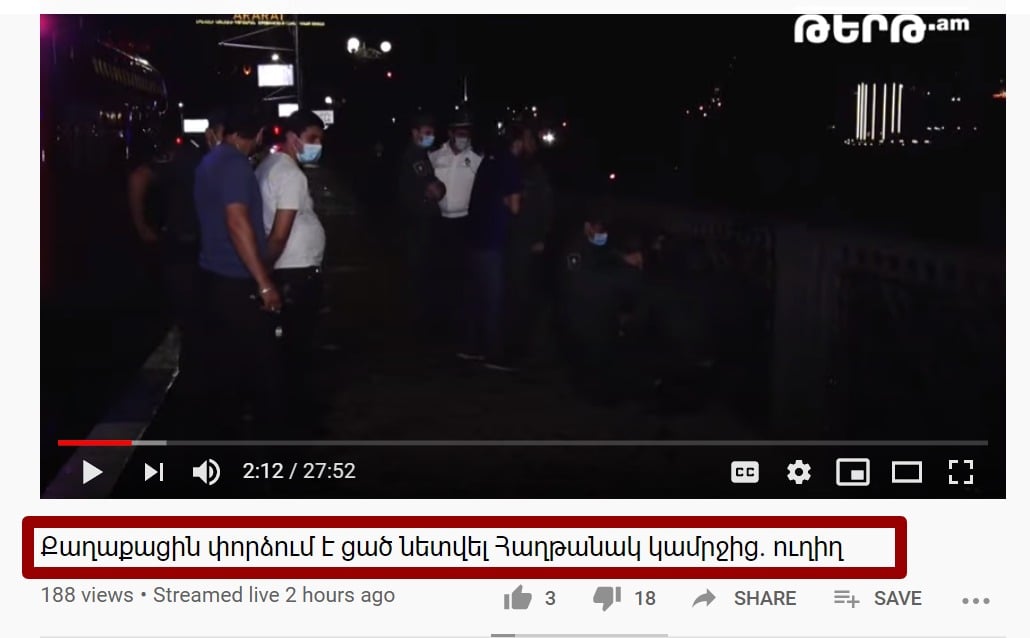
For about 25 minutes, the journalist was commenting live on the Internet on how a young man threatened to throw himself off the Victory Bridge in Yerevan.
During that time, the employees of the Ministry of Emergency Situations allowed the journalist to approach the person who was crossing the bridge leading to the gorge, to interview a person who was trying to commit suicide.
The journalist stressed several times that the person who announced his suicide did not mind giving an interview and warned that “we will not disclose identifying information.”
Then the camera went live going so far as to show the face of the young man giving the interview, thereby identifying that face (even if it was covered with a mask).
During the broadcast, we learned about his age, his history and, if you wanted to, identifying him became a matter of minutes.
The employees of the Ministry of Emergency Situations and Hovhannes Hunanyan, who arrived at the scene and introduced himself as a benefactor, managed to bring the young man who was threatening to commit suicide away from the ledge of the Victory Bridge and onto the side of the street.
“The suicide attempt has been prevented, thank you for following us,” the journalist concluded the live broadcast.
It is difficult to remember a case of a suicide attempt being broadcast live on Armenian air (TV, radio, or internet). If, of course, there was such a precedent.
It is not about a person going live on his phone or even shooting a video. It is about a journalistic group telling the story of a person who is going to jump off the bridge in a live broadcast and interviewing him.
The man is at the mouth of the gorge and may even fall accidentally, but he is giving an interview. And the desire to broadcast the sensation live defeats the feeling of danger.
Internet lives as a tool can be as useful as it is dangerous. Being the first in a live broadcast has a price and that price can be very expensive.
Suicide and even a suicide attempt is a serious decision. Broadcasting live on this topic, even more so!
The man on the edge of the Victory Bridge gave a live interview. He has social problems and saw the desperate step of the announced suicide as a possible path out of a difficult situation (during the broadcast it turned out that the man did not have a house to live in, he was promised temporary housing until the problem was solved).
And the media shows that step live, shows it as a possible example for those who have social, psychological, legal or any other problem.
This is a unique popularization of the announced suicide attempt. If someone managed to solve a social problem by attempting suicide with a live broadcast, then there may be those who want to repeat the same. Especially if the presence of the media(s) covering the event live is ensured.
When talking about suicide coverage, it is worth remembering the “Werther Effect.” Goethe’s book The Sorrows of Young Werther was so influential that it was banned in some areas. The reason was that the young men who were rejected by the girl they loved were repeating Werther’s step, committing suicide. For a desperate person, the example is contagious and here the parallel with the attempted suicide is obvious. In the 18th century, books were a powerful medium.
The World Health Organization’s “Preventing Suicide” publication states that publicizing suicide is directly related to the number of suicides: the more coverage, the more suicide attempts.
By this logic, after the live broadcast on July 23, an increase in cases of suicide attempts and the demand to cover those attempts live is expected.
And every time, good broadcasters have to make the decision on whether to go live to cover the suicide or not. And here the criteria of the broadcast content and their own rules of ethics will help to find answers. If, of course, they are defined.
Gegham Vardanyan
The views expressed in the column are those of the author's and do not necessarily reflect the views of Media.am.


Add new comment
Comments by Media.am readers become public after moderation. We urge our readers not to leave anonymous comments. It’s always nice to know with whom one is speaking.
We do not publish comments that contain profanities, non-normative lexicon, personal attacks or threats. We do not publish comments that spread hate.